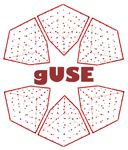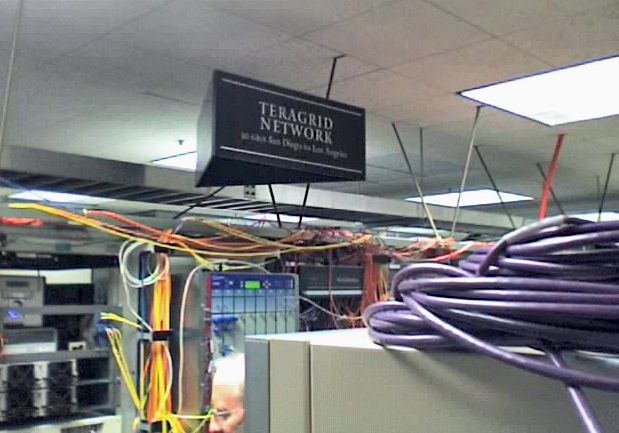|
GUSE
The Grid and Cloud User Support Environment (gUSE), also known as WS-PGRADE (Web Service – Parallel Grid Run-time and Application Development Environment) /gUSE, is an open source science gateway framework that enables users to access grid and cloud infrastructures. gUSE is developed by the Laboratory of Parallel and Distributed Systems ( LPDS) at Institute for Computer Science and Control (SZTAKI) of the Hungarian Academy of Sciences. A relevant requirement in the development of gUSE was to enable the simultaneous handling of a very large number of jobs, even in the range of millions, without compromising the response time at the user interface. In order to achieve this level of concurrency, the workflow management back-end of gUSE is implemented based on the web service concept of Service Oriented Architecture (SOA). Science Gateway Framework There are many user communities who would like to access several DCIs in a transparent way but they don't want to learn the pecul ... [...More Info...] [...Related Items...] OR: [Wikipedia] [Google] [Baidu] |
GUSE Architecture V2
The Grid and Cloud User Support Environment (gUSE), also known as WS-PGRADE (Web Service – Parallel Grid Run-time and Application Development Environment) /gUSE, is an open source science gateway framework that enables users to access grid and cloud infrastructures. gUSE is developed by the Laboratory of Parallel and Distributed Systems ( LPDS) at Institute for Computer Science and Control (SZTAKI) of the Hungarian Academy of Sciences. A relevant requirement in the development of gUSE was to enable the simultaneous handling of a very large number of jobs, even in the range of millions, without compromising the response time at the user interface. In order to achieve this level of concurrency, the workflow management back-end of gUSE is implemented based on the web service concept of Service Oriented Architecture (SOA). Science Gateway Framework There are many user communities who would like to access several DCIs in a transparent way but they don't want to learn the pecul ... [...More Info...] [...Related Items...] OR: [Wikipedia] [Google] [Baidu] |
LPDS
The Laboratory of Parallel and Distributed Systems (LPDS), as a department of MTA SZTAKI, is a research laboratory in distributed grid and cloud technologies. LPDS is a founding member of the Hungarian Grid Competence Centre, the Hungarian National Grid Initiative, and the Hungarian OpenNebula Community, and also coordinates several European grid/cloud projects. LPDS laboratory, in cooperation with other departments of MTA SZTAKI, was involved in the development of the SZTAKI Cloud and takes part in many cloud-based projects. The LPDS cloud research is focusing on the field of Infrastructure as a Service (IaaS)-based cloud systems to make the previously evolved products and services of LPDS available for cloud-based execution in a scalable and transparent way. Main research areas *Cloud systems *Scientific gateways for grid and cloud systems *Workflow-based IT *Grid computing, especially Desktop Grids *Interoperability between cloud and grid systems *Resource brokering in clo ... [...More Info...] [...Related Items...] OR: [Wikipedia] [Google] [Baidu] |
MTA SZTAKI Laboratory Of Parallel And Distributed Systems
The Laboratory of Parallel and Distributed Systems (LPDS), as a department of MTA SZTAKI, is a research laboratory in distributed grid and cloud technologies. LPDS is a founding member of the Hungarian Grid Competence Centre, the Hungarian National Grid Initiative, and the Hungarian OpenNebula Community, and also coordinates several European grid/cloud projects. LPDS laboratory, in cooperation with other departments of MTA SZTAKI, was involved in the development of the SZTAKI Cloud and takes part in many cloud-based projects. The LPDS cloud research is focusing on the field of Infrastructure as a Service (IaaS)-based cloud systems to make the previously evolved products and services of LPDS available for cloud-based execution in a scalable and transparent way. Main research areas *Cloud systems *Scientific gateways for grid and cloud systems *Workflow-based IT *Grid computing, especially Desktop Grids *Interoperability between cloud and grid systems *Resource brokering in clo ... [...More Info...] [...Related Items...] OR: [Wikipedia] [Google] [Baidu] |
The Computer And Automation Research Institute, Hungarian Academy Of Sciences
The Institute for Computer Science and Control (in short SZTAKI, hu, Számítástechnikai és Automatizálási Kutatóintézet) is a Hungarian research institute in Budapest, founded in 1964. Scope Its primary tasks include basic and application-oriented research in an interdisciplinary setting in the fields of engineering, computer science, information technology, intelligent systems as well as process control, multimedia and wide area networking. Further tasks of SZTAKI include training, contract-based target research, development and expert support for domestic and foreign industrial, governmental and other partners. The institute also operates a public advice service on knowledge-transfer of up-to-date research results and state-of-the-art technology to university students. SZTAKI has wide external relationships and different groups within the institute work on projects for well-known international and Hungarian companies and the number of European Union projects is also im ... [...More Info...] [...Related Items...] OR: [Wikipedia] [Google] [Baidu] |
Hungarian Academy Of Sciences
The Hungarian Academy of Sciences ( hu, Magyar Tudományos Akadémia, MTA) is the most important and prestigious learned society of Hungary. Its seat is at the bank of the Danube in Budapest, between Széchenyi rakpart and Akadémia utca. Its main responsibilities are the cultivation of science, dissemination of scientific findings, supporting research and development, and representing Hungarian science domestically and around the world. History The history of the academy began in 1825 when Count István Széchenyi offered one year's income of his estate for the purposes of a ''Learned Society'' at a district session of the Diet in Pressburg (Pozsony, present Bratislava, seat of the Hungarian Parliament at the time), and his example was followed by other delegates. Its task was specified as the development of the Hungarian language and the study and propagation of the sciences and the arts in Hungarian. It received its current name in 1845. Its central building was inaugurate ... [...More Info...] [...Related Items...] OR: [Wikipedia] [Google] [Baidu] |
Graphical User Interface
The GUI ( "UI" by itself is still usually pronounced . or ), graphical user interface, is a form of user interface that allows users to interact with electronic devices through graphical icons and audio indicator such as primary notation, instead of text-based UIs, typed command labels or text navigation. GUIs were introduced in reaction to the perceived steep learning curve of CLIs ( command-line interfaces), which require commands to be typed on a computer keyboard. The actions in a GUI are usually performed through direct manipulation of the graphical elements. Beyond computers, GUIs are used in many handheld mobile devices such as MP3 players, portable media players, gaming devices, smartphones and smaller household, office and industrial controls. The term ''GUI'' tends not to be applied to other lower-display resolution types of interfaces, such as video games (where HUD (''head-up display'') is preferred), or not including flat screens like volumetric displays because ... [...More Info...] [...Related Items...] OR: [Wikipedia] [Google] [Baidu] |
UNICORE
UNICORE (UNiform Interface to COmputing REsources) is a grid computing technology for resources such as supercomputers or cluster systems and information stored in databases. UNICORE was developed in two projects funded by the German ministry for education and research (BMBF). In European-funded projects UNICORE evolved to a middleware system used at several supercomputer centers. UNICORE served as a basis in other research projects. The UNICORE technology is open source under BSD licence and available at SourceForge. History The concept of grid computing was first introduced in the book "The Grid: Blueprint for a New Computing Infrastructure" at the end of 1998. By 1997, the development of UNICORE was initiated for German supercomputer centers as an alternative for the Globus Toolkit. The first prototype was developed in the German UNICORE project, while the foundations for the production version were laid in the follow-up project UNICORE Plus, which ended in 2002. Follow ... [...More Info...] [...Related Items...] OR: [Wikipedia] [Google] [Baidu] |
Extreme Science And Engineering Discovery Environment
TeraGrid was an e-Science grid computing infrastructure combining resources at eleven partner sites. The project started in 2001 and operated from 2004 through 2011. The TeraGrid integrated high-performance computers, data resources and tools, and experimental facilities. Resources included more than a petaflops of computing capability and more than 30 petabytes of online and archival data storage, with rapid access and retrieval over high-performance computer network connections. Researchers could also access more than 100 discipline-specific databases. TeraGrid was coordinated through the Grid Infrastructure Group (GIG) at the University of Chicago, working in partnership with the resource provider sites in the United States. History The US National Science Foundation (NSF) issued a solicitation asking for a "distributed terascale facility" from program director Richard L. Hilderbrandt. The TeraGrid project was launched in August 2001 with $53 million in funding to four sites: ... [...More Info...] [...Related Items...] OR: [Wikipedia] [Google] [Baidu] |
Grid Computing
Grid computing is the use of widely distributed computer resources to reach a common goal. A computing grid can be thought of as a distributed system with non-interactive workloads that involve many files. Grid computing is distinguished from conventional high-performance computing systems such as cluster computing in that grid computers have each node set to perform a different task/application. Grid computers also tend to be more heterogeneous and geographically dispersed (thus not physically coupled) than cluster computers. Although a single grid can be dedicated to a particular application, commonly a grid is used for a variety of purposes. Grids are often constructed with general-purpose grid middleware software libraries. Grid sizes can be quite large. Grids are a form of distributed computing composed of many networked loosely coupled computers acting together to perform large tasks. For certain applications, distributed or grid computing can be seen as a special type of ... [...More Info...] [...Related Items...] OR: [Wikipedia] [Google] [Baidu] |
Cloud Computing
Cloud computing is the on-demand availability of computer system resources, especially data storage ( cloud storage) and computing power, without direct active management by the user. Large clouds often have functions distributed over multiple locations, each of which is a data center. Cloud computing relies on sharing of resources to achieve coherence and typically uses a "pay as you go" model, which can help in reducing capital expenses but may also lead to unexpected operating expenses for users. Value proposition Advocates of public and hybrid clouds claim that cloud computing allows companies to avoid or minimize up-front IT infrastructure costs. Proponents also claim that cloud computing allows enterprises to get their applications up and running faster, with improved manageability and less maintenance, and that it enables IT teams to more rapidly adjust resources to meet fluctuating and unpredictable demand, providing burst computing capability: high computing p ... [...More Info...] [...Related Items...] OR: [Wikipedia] [Google] [Baidu] |
Enabling Grids For E-sciencE
In psychotherapy and mental health, enabling has a positive sense of empowering individuals, or a negative sense of encouraging dysfunctional behavior.elinewberger.com From the page on 'enabling', by Eli H. Newberger, M.D., referenced by that web page to ''The Men They Will Become'' ch.18 "Enabling". Positive As a positive term, "enabling" is similar to , and describes patterns of interaction which allow individuals to develop and grow. These patterns may be on any scale, for example within the |



_edited.jpg)